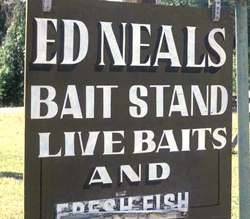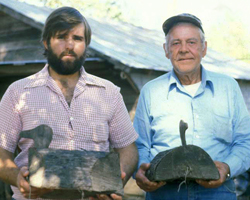Introduction to Delta Pieces: Northeast Louisiana Folklife
Map: Cultural Micro-Regions of the Delta, Northeast Louisiana

The Louisiana Delta: Land of Rivers








Ethnic Groups










Working in the Delta








Homemaking in the Delta




Worshiping in the Delta



Making Music in the Delta




Playing in the Delta







Telling Stories in the Delta



Delta Archival Materials
Bibliography


Hunting and Fishing: Delta Life
By Hiram Ford "Pete" Gregory, III
Editor's Note: In the early 1990s, Pete Gregory wrote these personal reflections about Northeast Louisiana's Delta and they are published with minimal editing. Also see his Musings on the Louisiana Delta from a Native Son.
William Faulkner's epic descriptions of deer and bear hunting in the Mississippi portion of the Delta hold for the Louisiana side as well. Deer hunting, squirrel hunting, and dove hunting are universal pastimes in the lowlands. One hunter who lived in his family's old home at Liddieville was asked about the dozens of racks of deer antlers hanging in the breezeway of the old structure. He smiled and replied, "They represent many hours of squattin' on a chunk."
Lots of Delta men—and a few women—still "take to the woods" every deer season. Once there, they start "squatting on a chunk" waiting on the deer. These "standers" play by almost mystical rules. Youngsters who kill their first deer are "bloodied"—initiated into a world of their ancestors. The hot blood of the fresh kill is marked on their foreheads or thrown in their faces! Should a young hunter miss, his shirttail is cut off and nailed to the camp wall!
The bond between the woods, dogs, the hunted animals, and the hunter starts early. Boys are given their first guns at about 8-10 years of age. Usually, they start with a .22 caliber rifle and work up to a shotgun, usually .12 or .16 gauge. Some hunt all their lives with a .20 gauge or even a .410 gauge, but the larger shotguns are more common for adults. Older hunters use them for a wider range of game including deer, squirrel, rabbit, doves, ducks and rarely, turkey or bear.
Mythic events and almost superman tales of great hunters are everywhere in the Delta. In the Macon Ridge country, the legendary Ben Lilly, who guided Theodore Roosevelt on his bear hunts into the Tensas swamps, is still talked about. Lilly's exploits, recorded by J. Frank Dobie in his work The Ben Lilly Legend (1981), were recalled in the Boeuf River swamps, too. All around Winnsboro in Franklin Parish, old-timers talked about him. The late Uncle Billy Hampton of Winnsboro and Liddieville recalled having seen Ben Lilly at his father's house when he was a child. He had come after a bear! Uncle Billy recalled his father drank bear oil like water: "It was light like water."1
Uncle Billy was himself a legend. He was a fisherman, though as a young man he had been a turkey hunter. His wife paraphrased a folk ballad to fit him: "Fishin' Bill, he never worked and never will." Hampton moved to Black River in the 1930s and died in Ferriday, Louisiana. He guided sports fishermen from Washington D.C., Texas, Mississippi, Indiana, California, and all over. Some believed he never failed to catch fish. Uncle Billy built his own boats of "clear cypress" boards and had two boats that he paddled all day without a sound from his paddle. He could always put his fishermen on fish. Once, fishing with a doctor from Mississippi, his skill seemed to fail him. They were fishing Saline Bayou west of Larto Lake and he recalled, "We met a net fisherman running his nets. He asked how we were, and I said, 'Pretty good.' I said, 'What kind of bait are they biting today?' 'Silver bait is best,' he said. 'We got our mess of fish right there!'" 2
Likely, the prime macho story is told by a younger hunter. "I was in the tree stand, saw the buck coming and I dropped on his back and grabbed the horns, around his neck. He kept running! I took my knife and began cutting. I thought it was the deer. It was my own hand—cut the hell out of myself! When I realized it, I cut the deer's throat. At least I got my buck!"
The ultimate tale is told on Black River. "The big buck hit the bayou ahead of the dogs. We were in the boat. Buddy said, 'Run alongside him and throw that rope over his horns and we'll kill him. 'We caught him, motor wide open, and that sucker went down under the water. The whole front end of the damned boat went under. We had to chop him loose so he wouldn't sink the boat!"
In the Tensas Basin, hunting camps formed starting in the early 20th century. Today hunting clubs have formalized these camps and much of the privately owned woodland and wetland is now lease land. Hunting and fishing, once egalitarian activities, are more and more linked to income levels. Formerly the "camps" were built by a group of men who sometimes leased a site for a building, or at other times built on land owned by one of the group, and only that group hunted out of that camp. Lately, camps lease land which they restrict to their members—as hunting pressure increased with the expansion of soybean farming, outsiders were evicted.
Older, larger camps have about disappeared and the hunting camps invite and advertise for paid memberships. The corporate farm, Louisiana Delta Plantation, is typical. It advertises hunting—ducks usually—and crawfishing in the spring. Leases on a duck blind may bring the farm as much as $3,000. The plantation furnishes blinds, transportation, and decoys. Guides may also be arranged for if the hunter requests it. Deer Park in southern Concordia Parish was long the focus for deer and squirrel hunters. It was the site of several large camps. Uncle Billy Hampton recalled such a camp, but most have disappeared today.
Stories about shooting events, accidents, "the one that got away" are common among hunters. "Tell him about Big Red," one hunter's wife urged a story. "His horse fell and broke his leg. He was so big, the hospital at Vidalia couldn't find him a gown so they had to pin bedsheets around him!" The following story is typical:
After the war a young man came in with a fancy rifle in its own case and all that. The old hunters all looked at it and wondered about him. They asked him if he could shoot it. "I shoot pretty well," he said. They took him way back to a gate on the corner, away from the other hunters. Left him there.
The dogs started running way off across the swamp. Then we heard a shot, "Pow!" Another, "Pow!" Then "Pow-pow-pow"—five shots. Big Red came up in the jeep and asked if I'd heard them shots. "Sounds like that high-powered rifle to me," I said.
"Me, too," Big Red said. So we went over there. By that time all them old hunters was coming in to see what had happened. The fellow was sitting there on that gatepost, smoking a cigarette.
We asked if he'd seen any deer. "Yep," he said, "five of 'em."
"Were there any bucks?"
"Yeah, one big one. I didn't miss any of them." Sure enough, he'd hit them all—shot the buck and four does! He said he was sorry, but Big Red had told him not to let any deers get by him; he didn't know he wasn't supposed to kill doe. We had to get busy and dress those deer; the game warden came about every hour! That fellow had been a sharpshooter in the war! We didn't know that.
The hunters usually sent a cook ahead who stayed in the kitchen the whole season. Before surfaced roads were available into the swamp, they came from Alexandria, Louisiana, to Torras on Red River, crossed in a flat boat and were carried by mule and wagon to the camp. Usually, they invited medical doctors to hunt without any cost, a sort of insurance policy against snakebite or other injury! Privileged guests, the doctors were well cared for—thirty miles to a hospital in the nearest town, over bad roads made them really important people.
Hunting was controlled. Each day the camp's hunters went out on "stands." The use of high-powered rifles was, in the old days, rare. Shotguns were more common. In the flat expanse of the Delta the shotgun was, in dense woodlands, a much safer weapon. Some older hunters forbade younger family members from purchasing rifles, insisting on shotguns as safer weapons.
If there were riflemen in the camp, they were placed on "rifle stands" so they did not shoot in the direction of other hunters. Each hunter knew not to wander, but to sit or stand where they were placed. The dogs were unleashed, and usually a man on horseback followed them. Hunters shot the deer running ahead of the dogs.
Hunting camps still exist in more and more isolated patches of bottomland. Deer antlers still adorn the walls of the houses and barns of both the rich and poor alike. People of all ages, all colors learn to hunt and fish at tender ages. Some folkways like turtle catching, harpooning buffalo fish, moss gathering, trapping, and night hunts are becoming rare events. Outlawed by conservationists, and environmentally less feasible because of the changing landscape, one hears less and less about such things. Guns, dogs, and the deer hunt are visible components of Delta life. On Labor Day the troops gather about corn and milo fields to shoot the humble doves, the hardest of all birds to shoot!
Notes
1. The experiences of another historic Delta hunter and guide for Roosevelt in Tensas parish, Holt Collier, are chronicled by Buchanan's Holt Collier: His Life, His Roosevelt Hunts, and the Origin of the Teddy Bear. See "Ben Lilly, Strongman of Morehouse Parish," as told by James B. Rider from Bastrop, Louisiana. This version appeared in the publication Swapping Stories: Folktales from Louisiana.
2. "Silver bait" refers to coins; i.e. the doctor was being asked to pay to find out where the fish were biting or to purchase part of the net fisherman's catch.
Works Cited
Buchanan, Minor Ferris. Holt Collier: His Life, His Roosevelt Hunts, and the Origin of the Teddy Bear. Jackson, MS: Centennial Press, 2002.
Dobie, J. Frank. The Ben Lilly Legend. Austin: University of Texas Press, 1981.
Lindahl, Carl, Maida Owens, and C. Renee Harvison. Swapping Stories: Folktales from Louisiana. Jackson, MS: University Press of Mississippi, 1997.





